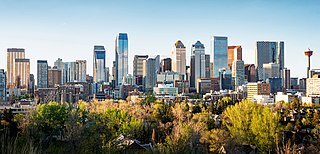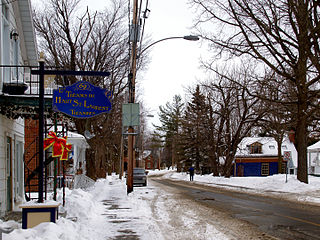
Queens County is located in central New Brunswick, Canada. The county shire town is the village of Gagetown. The county was named as an expression of loyalty to the Crown and to commemorate a group of earlier settlers originally from Queens County, New York.

A conurbation is a region comprising a number of metropolises, cities, large towns, and other urban areas which, through population growth and physical expansion, have merged to form one continuous urban or industrially developed area. In most cases, a conurbation is a polycentric urbanised area in which transportation has developed to link areas. They create a single urban labour market or travel to work area.

The census geographic units of Canada are the census subdivisions defined and used by Canada's federal government statistics bureau Statistics Canada to conduct the country's quinquennial census. These areas exist solely for the purposes of statistical analysis and presentation; they have no government of their own. They exist on four levels: the top-level (first-level) divisions are Canada's provinces and territories; these are divided into second-level census divisions, which in turn are divided into third-level census subdivisions and fourth-level dissemination areas.

Brossard—La Prairie was a federal electoral district in Quebec, Canada, that was represented in the House of Commons of Canada from 1997 to 2015. As of 2011, its population is 128,001.

The Calgary Metropolitan Region (CMR), also commonly referred to as the Calgary Region, is a conglomeration of municipalities centred on Calgary, the largest city in Alberta.

Greater Montreal is the most populous metropolitan area in Quebec and the second most populous in Canada after Greater Toronto. In 2015, Statistics Canada identified Montreal's Census Metropolitan Area (CMA) as 4,258.31 square kilometres (1,644.14 sq mi) with a population of 4,027,100, almost half that of the province.

Italian Canadians are Canadian-born citizens who are fully or partially of Italian descent, whose ancestors were Italians who migrated to Canada as part of Italian diaspora, or Italian-born people in Canada. According to the 2021 Census of Canada, 1,546,390 Canadians claimed full or partial Italian ancestry. They comprise a subgroup of Southern European Canadians which is a further subgroup of European Canadians. The census enumerates the entire Canadian population, which consists of Canadian citizens, landed immigrants and non-permanent residents and their families living with them in Canada. Residing mainly in central urban industrial metropolitan areas, Italian Canadians are the seventh largest self-identified ethnic group in Canada behind French, English, Irish, Scottish, German and Chinese Canadians.

The Winnipeg Metropolitan Region is a metropolitan area in the Canadian province of Manitoba located in the Red River Valley in the southeast portion of the province of Manitoba, Canada. It contains the provincial capital of Winnipeg and 17 surrounding rural municipalities, cities, and towns.

Chinatown in Montreal is located in the area of De la Gauchetière Street in Montreal. The neighbourhood contains many Asian restaurants, food markets, and convenience stores as well being home to many of Montreal's East Asian community centres, such as the Montreal Chinese Hospital and the Montreal Chinese Community and Cultural Centre.

Ormstown is a municipality in Quebec, Canada, which is situated on the Châteauguay River in the heart of the Châteauguay Valley. It is approximately one hour southwest of Montreal and 20 minutes north of New York State in the United States. The population as of the 2021 Canadian census was 3,917.

The Edmonton Metropolitan Region (EMR), also commonly referred to as Greater Edmonton or Metro Edmonton, is a conglomeration of municipalities centred on Edmonton, the capital of the Canadian province of Alberta.

Greater Moncton is a census metropolitan area comprising Moncton, Riverview, and Dieppe in New Brunswick, Canada.

Beauharnois is a city located in the Beauharnois-Salaberry Regional County Municipality of southwestern Quebec, Canada, and is part of the Greater Montreal Area. The city's population as of the Canada 2021 Census was 13,638. It is home to the Beauharnois Hydroelectric Power Station, as well as the Beauharnois Lock of the Saint Lawrence Seaway.

Très-Saint-Sacrement is a parish municipality located along the Châteauguay River in the Montérégie region of Quebec, Canada. The population as of the 2021 Canadian census was 1,189. Established in 1885, the municipality completely encloses the village of Howick, which was incorporated as a separate entity in 1915.

Saint-Anicet is a municipality in Le Haut-Saint-Laurent Regional County Municipality in the Montérégie administrative region of Quebec. The population as of the Canada 2021 Census was 2,754.

The Greater Toronto and Hamilton Area (GTHA) is a contiguous urban region that is composed of some of the largest cities and metropolitan areas by population in the Canadian province of Ontario. The GTHA consists of the Greater Toronto Area (GTA) and the city of Hamilton. The GTA is Canada's most populous metropolitan area that includes the city of Toronto and the regional municipalities of Halton, Peel, York, and Durham. The GTHA forms the core of a larger urban agglomeration known as the Golden Horseshoe.

The Saskatoon region is the greater metropolitan area of Saskatoon, Saskatchewan. As of 2021 the Statistics Canada estimates the region's population to be 317,480 people.

Greater Fredericton is the name given to the area encompassing the City of Fredericton in New Brunswick, Canada and its surroundings. Most of this area is along the Saint John River mainly on portions of Route 105, Route 102 and Route 101. Some of the areas mentioned below are included in the area of Greater Fredericton. It is also known as Fredericton Census Agglomeration, Fredericton CA, or The Capital Region. In 2006, the population of the census agglomeration was 94,268



















